In a new study entitled “Roflumilast for asthma: Efficacy findings in mechanism of action studies,” researchers evaluated the potential therapeutic effects of roflumilast, a treatment used in patients with severe chronic obstructive pulmonary disease, in asthma patients. The study was published in the journal Pulmonary Pharmacology & Therapeutics.
Inhaled corticosteroids (ICS) are recommended as the most effective treatment for asthma – ICS acts by reducing inflammation in lungs’ airways and sputum production via the bronchial tubes – but their prolonged use is associated with both local and systemic side effects, the latter most commonly including immunosuppression and adrenal suppression.
An alternative treatment with roflumilast – an oral phosphodiesterase-4 (PDE4) inhibitor – used as a treatment for chronic obstructive pulmonary disease was suggested as a potential new treatment for asthma (in COPD patients, roflumilast administration was shown to improve lung function and reduce frequency of exacerbations). The effect of roflumilast in asthma patients is less understood, particularly its mechanisms of action and bronchodilatory effects.
The authors investigated the therapeutic efficacy and mechanism of action of roflumilast in patients with asthma. To this end, they analyzed data from 197 patients enrolled in eight randomized, placebo-controlled, double-blind phase I–III studies conducted in 14 centers across Europe, North America and South Africa from 1997 to 2005. They compared the effects of different doses of roflumilast (250μg, 500μg or 1000μg) to placebo control patients, focusing particularly on sputum composition and production and exercise-induced bronchoconstriction. Additional parameters included the extent of the early allergic response and measurement of inflammatory markers.
The team observed that roflumilast significantly reduced late asthmatic reaction by 43% and 27%, with 500 ug and 250 ug of roflumilast, respectively; early asthmatic reaction was also reduced by 28% and 25%, with the respective doses of roflumilast, when compared to placebo control group. Furthermore, authors found that roflumilast reduced airway inflammation (induced by allergens) accompanied by a decrease in inflammatory cells counts (eosinophils and neutrophils) and inflammatory marker tumour necrosis factor α. The side effects were similar to those observed in COPD patients (nausea, headache and diarrhea), except no weight loss was registered in asthma patients.
As a result, the researchers note that these findings show that the anti-inflammatory effects of roflumilast, already registered in COPD patients, are also observed in asthma patients, highlighting its potential use in the treatment of asthma.


I never see any positive comments re beneficial results of Roflumilast treatment: plenty of nasty side effects though. Has anyone at all been significantly helped by this drug?